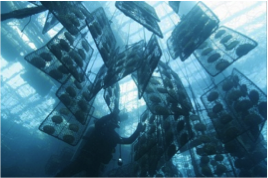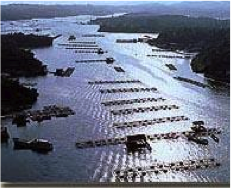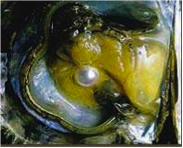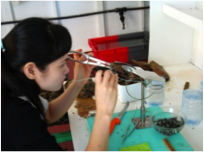Pearl Farming
Bred for Quality

Early pearl cultivation depended entirely on wild oysters. Now pearl cultivation is more selective. Japanese scientists isolate strains of oysters possessing superior pearl bearing qualities. These selectively bred oysters produce pearls of exceptional luster and color clarity.
Enter the Nucleus
Highly skilled technicians open the live pearl oysters carefully, and then surgically implant a small polished shell bead and piece of mantle tissue in each. The shell bead serves as the nucleus around which the oyster secretes layer after layer of nacre, the crystalline substance that forms the pearl.
Back to the Sea
The nucleated oysters are returned to the sea. There, in sheltered bays rich in natural nutrients, the oysters feed and grow, depositing lustrous layers of nacre around their nuclei. In winter, the oysters are moved south to warmer waters.
Pearl Rafts

The nucleated oysters are suspended from rafts such as these in order to provide the best growing conditions. Pearl technicians check water temperatures and feeding conditions daily at various water depths and then move the oysters up or down to take advantage of the best growing conditions.
Pampered Oysters
Periodically, the pearl-bearing oysters are lifted from the sea for cleaning and health treatments. Seaweed, barnacles and other undersea growths that might impede feeding are removed from their shells. Then the shells are treated with medicinal compounds that discourage parasites from injuring the oysters.
The Birth of a Pearl

At last, the oysters are ready for harvest. Those that have survived such perils of the sea as typhoons, suffocating red tides, and attacks from predators are brought ashore and opened. If everything has gone well, the result is a lovely, lustrous and very valuable pearl.
Preparing Cultured Pearls
Sorting

Unlike imitation pearls, no two cultured pearls are ever exactly alike. Each has its own unique combination of size, shape, luster and color. The art of assembling pearls into a necklace, a pair of earrings or any other jewellery calls for refined skills in assembling similar looking pearls. Here, pearls are sorted by experts with highly trained eyes and years of experience.
Drilling

Drill holes must be made with care and precision. An inexperienced operator can split or ruin pearls with careless handling. A hole is drilled even slightly off-center can ruin a necklace or piece of jewellery that depends upon the symmetrical assembly of its pearls. This stage in the preparation of cultured pearls for jewellery is a very delicate operation.
Stringing and Blending
Because no two cultured pearls are ever exactly alike, pearl dealers must cull through about 10,000 pearls to find enough that are so closely matched that they can be assembled together to make a single necklace. Here, closely matching pearls are blended to be strung into a beautiful necklace.





